Believe it or not, money plants can bring more than just luck – they can also bring safety. Did you know that there are 25 different types of money plants? Each has its own unique benefits that can help increase safety in the home. In this article, we’ll explore the different money plants available, their placement, and the benefits they bring. Read on to learn more about how money plants can improve safety in your home.

Contents
- 1 What Is A Money Plant?
- 2 Where To Place A Money Plant?
- 3 Benefits Of Different Types Of Money Plants
- 4 Different Types Of Money Plants
- 4.1 Pilea Peperomioides (Chinese Money Plant)
- 4.2 Jade Plant
- 4.3 Money Tree
- 4.4 Golden Pothos
- 4.5 Split Leaf Money Plant
- 4.6 Silvery Ann Pothos
- 4.7 Lucky Bamboo
- 4.8 Marble Queen Pothos
- 4.9 Silver Money Plant
- 4.10 Neon Pothos
- 4.11 Silver Dollar Vine
- 4.12 Rubber Plant
- 4.13 Monkey Mask Money Plant
- 4.14 Big Leaf Money Plant
- 4.15 Marble Prince Pothos
- 4.16 Pennywort
- 4.17 Ribbon Plant
- 4.18 Bamboo Palm
- 4.19 Peace Lily
- 4.20 Jade Pothos
- 4.21 Manjula Pothos
- 4.22 N’Joy Pothos
- 4.23 Cebu Blue Pothos
- 4.24 Hawaiian Pothos
- 4.25 Glacier Pothos
- 5 Conclusion
What Is A Money Plant?
Frequently, you may hear people talking about money plants and wondering what they are. Money plants are house plants that are believed to bring wealth and prosperity to your home. They come in a variety of different shapes and sizes, from the Chinese Money Plant with its round coin-like leaves to the Jade Plant, with its slow but steady growth.
All money plants are thought to be connected with getting richer due to two ancient concepts called Feng Shui and Vastu. Feng Shui is the Chinese belief that the placement of objects in a home affects the flow of energy and that placing a money plant in the right spot can bring prosperity. Vastu is an Indian concept that also states money plants are a good luck charm that can bring financial success. While money plants may not actually bring wealth and prosperity, they are certainly a great addition to any home.
Where To Place A Money Plant?
Now that you know what a money plant is, it’s time to discuss where you should place it for it to bring you wealth and prosperity. According to the ancient concepts of Feng Shui and Vastu, the best place to put your money plant is in the southeast direction of your home. This is because this direction is associated with abundance, stability, and wealth. On the other hand, if you place your money plant in the east-west direction, it will supposedly have the opposite effect.
To get the most out of your money plant, make sure that you place it in the right area of your home. Place it in an area that gets plenty of natural light, but not direct sunlight. Also, try to keep it away from drafts or strong winds, as this could damage the plant.
When taking care of your money plant, remember to water it regularly and give it a good amount of fertilizer. Lastly, make sure to trim it from time to time so that it can grow healthily. By following these basic guidelines, you can ensure that your money plant will bring you wealth and prosperity for years to come.
Benefits Of Different Types Of Money Plants
You’ll benefit from different types of money plants in more ways than one. Not only are they renowned for their ability to bring wealth, but they also require minimal care and can help purify the air. According to NASA, money plants can reduce the toxins in the air, making them an ideal choice for indoor plants. Additionally, they are low-maintenance and can survive in a wide range of conditions, from full sun to partial shade.
Another great benefit of money plants is their ability to absorb moisture from the atmosphere. This helps to keep the air inside your home at a comfortable level, making it easier to breathe. If you live in a dry climate, the air-purifying benefits of money plants are even more pronounced.
Money plants also come in a variety of shapes and sizes. This means you can find one that fits into your home décor easily. From small to large, and from simple to ornate, there’s sure to be a money plant that’s perfect for your space.
Different Types Of Money Plants
Are you looking for the perfect money plant for your home or office? Look no further than the pilea peperomioides (Chinese money plant), jade plant, money tree, golden pothos, or split-leaf money plant. These are some of the most popular money plants and are sure to bring an extra touch of luck and prosperity to your space.
Pilea Peperomioides (Chinese Money Plant)
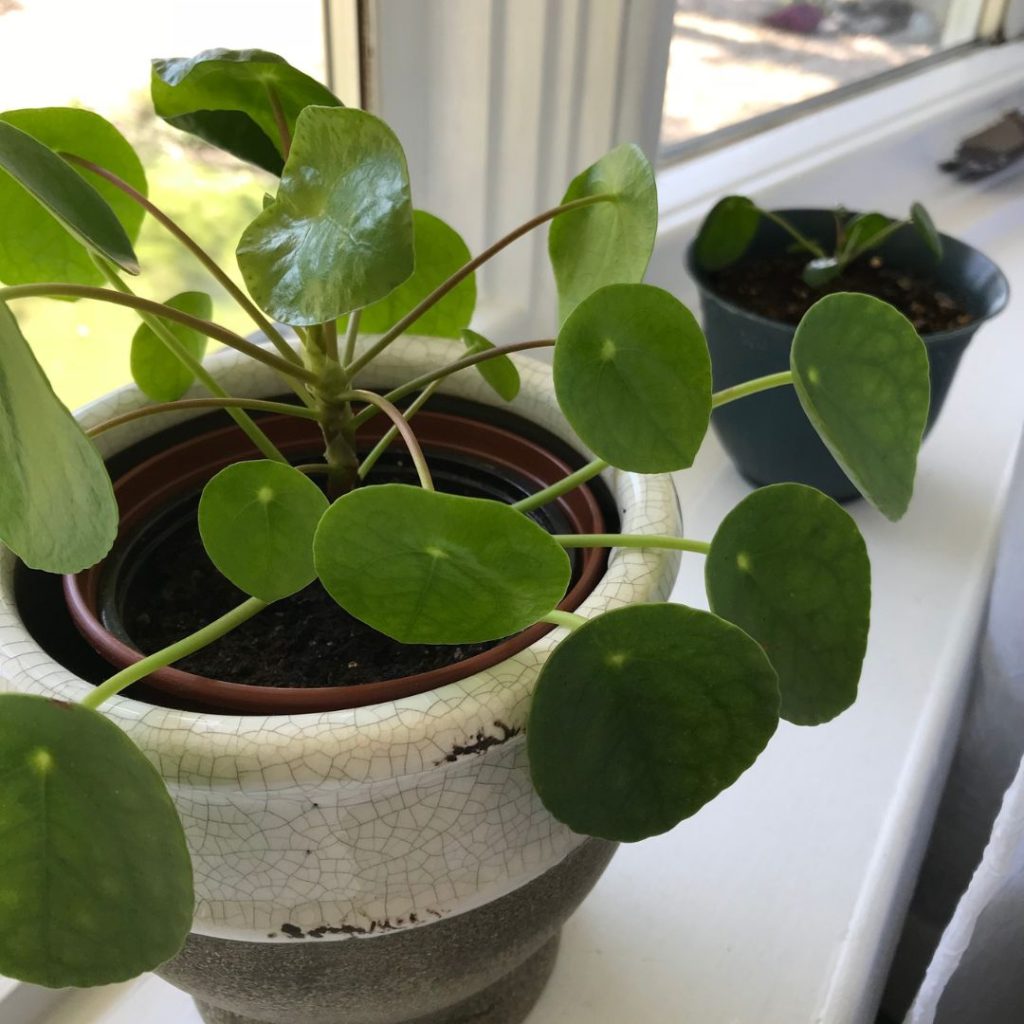
Among the different types of money plants, the Pilea Peperomioides (also known as the Chinese money plant) stands out. This attractive and low-maintenance houseplant is grown for its round, bright green leaves and easy-to-propagate nature. It can be propagated from stem cuttings, making it easy to share with friends and family.
The plant thrives in bright, indirect sunlight and only needs to be watered once the top layer of soil is dry. It is also an excellent air purifier and helps remove toxins from the air. This plant is perfect for those looking for a simple, attractive houseplant with minimal effort required. However, it should be noted that this plant is toxic if ingested, so care should be taken if you have pets or small children.
Related Post:
40+ Types Of Pilea Plants (With Pictures)
Jade Plant
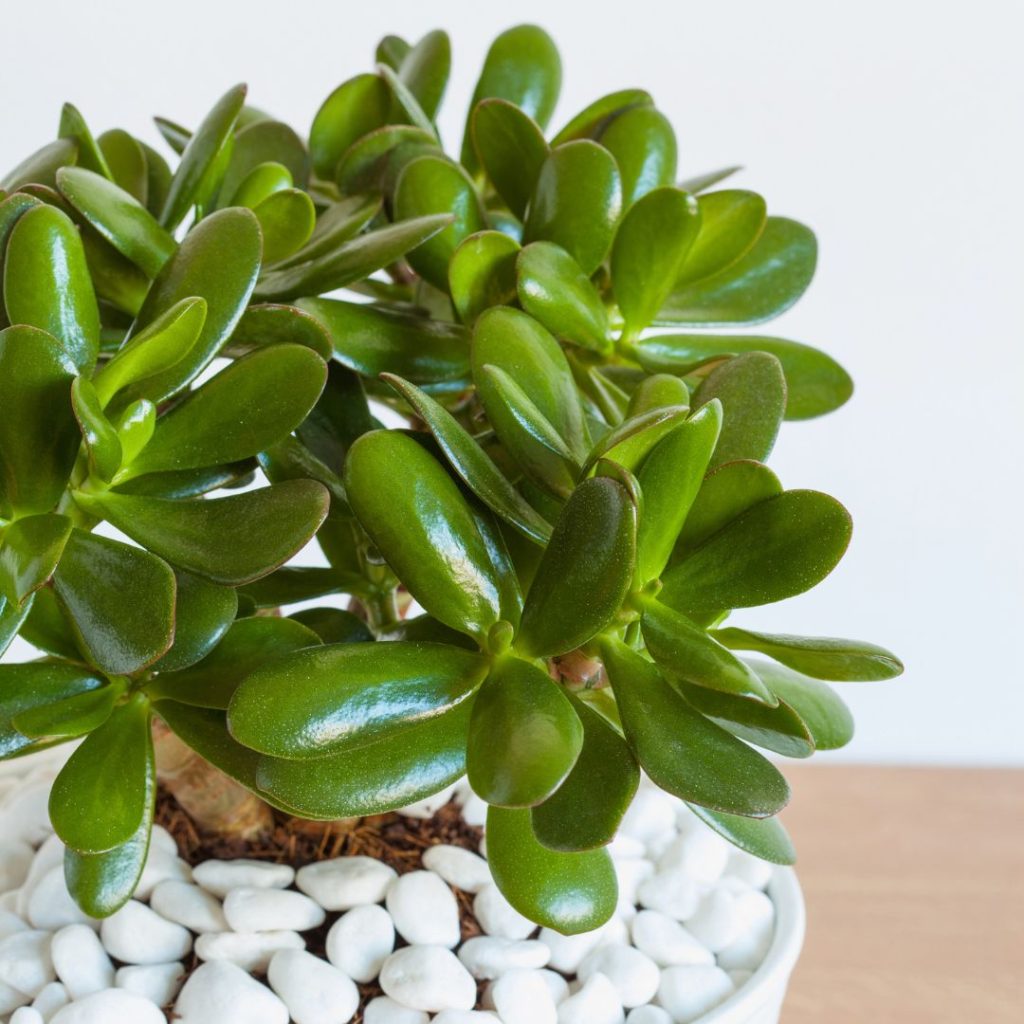
Take a look at the jade plant, a popular type of money plant that can bring a touch of luck and prosperity to your home. The jade plant, or Crassula Ovata, is a succulent that is native to South Africa. It has glossy, thick leaves and woody stems that come together to create a unique-looking plant. Its leaves are believed to bring luck and prosperity, making it a popular choice for Feng Shui enthusiasts.
The jade plant is easy to care for and prefers bright, indirect sunlight and well-draining soil. It should be watered regularly, but should never be left sitting in water. It is also important to monitor the humidity levels, as too much humidity can cause the leaves to rot. If you’re looking for a money plant with a unique look, the jade plant is a great choice.
Related Post:
22 Popular Kinds of Jade Plants (With Pictures)
Money Tree
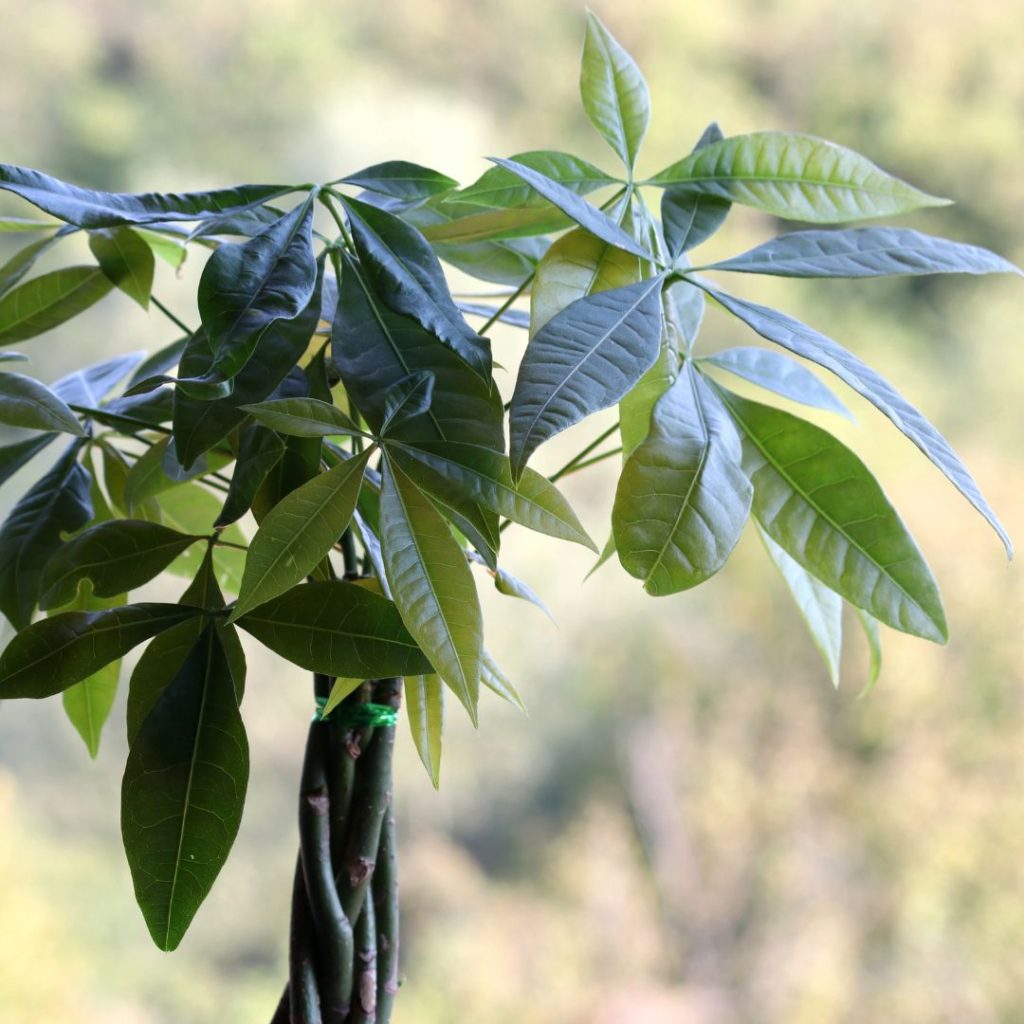
Aside from the jade plant, another popular type of money plant is the money tree. Money trees, also known as Malabar chestnuts, are a species of evergreen tropical trees originating in Southern India and Southeast Asia. Money trees are so named because of their five-lobed leaves that are believed to bring fortune and luck. They are also a symbol of prosperity and good luck in many cultures.
Money trees are easy to grow and can live for many years. They enjoy bright indirect light and can be watered once a week. They should be fertilized regularly with a liquid fertilizer and should be pruned to ensure they remain healthy and compact. Money trees make a great addition to any home or office and can bring joy to any living space.
Golden Pothos
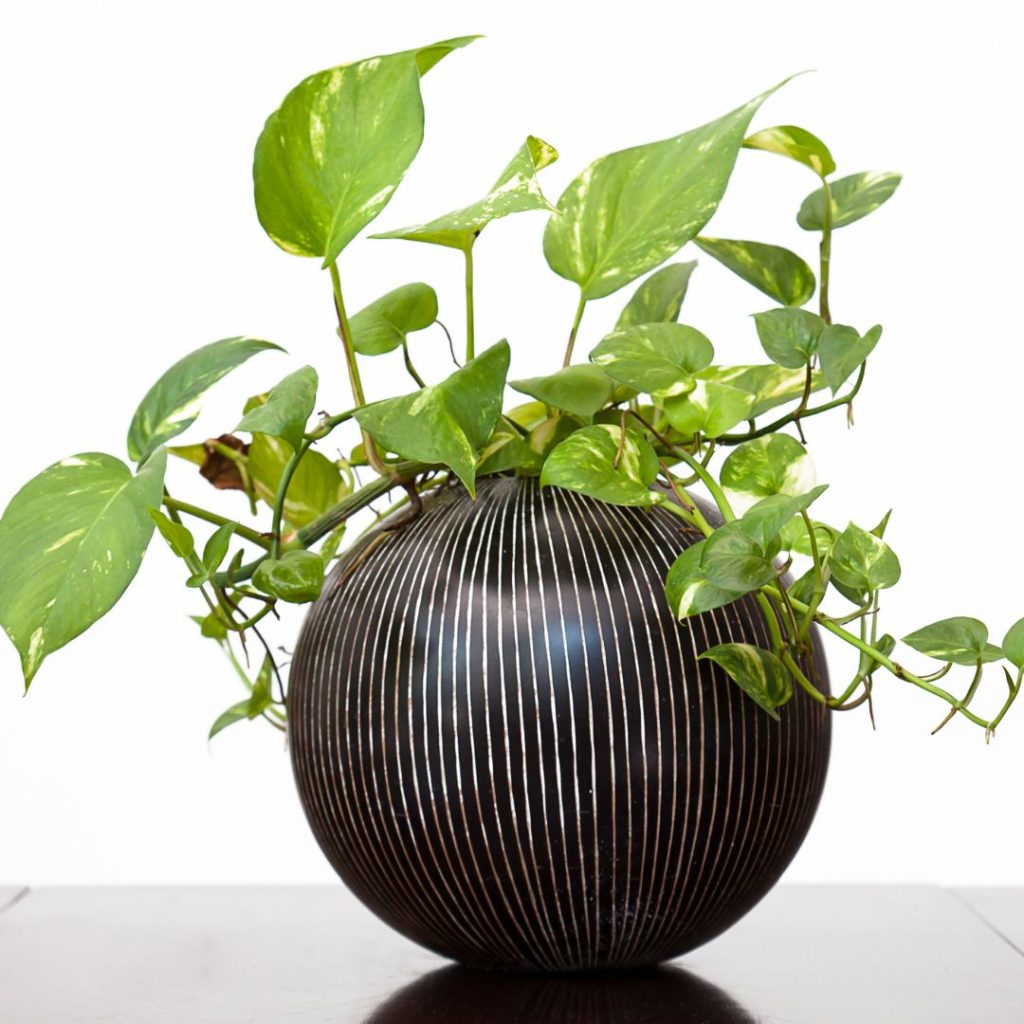
Discover the golden pothos, a unique type of money plant that is known for its eye-catching leaves and easy-care nature. It’s a popular choice for novice gardeners and those who want a low-maintenance houseplant. The golden pothos is a fast-growing trailing or climbing plant with golden and green leaves. It’s a great addition to brighten up any room with its vibrant colors. With its ability to survive in low light and its hardy nature, it’s an ideal choice for both indoor and outdoor gardens.
Furthermore, the Golden Pothos is also known for its air-purifying properties, making it a great choice for those looking to improve air quality in their homes. To care for your golden pothos, water it regularly and provide bright, indirect sunlight. Pruning its long vines occasionally will also help it to stay healthy and vigorous.
Split Leaf Money Plant
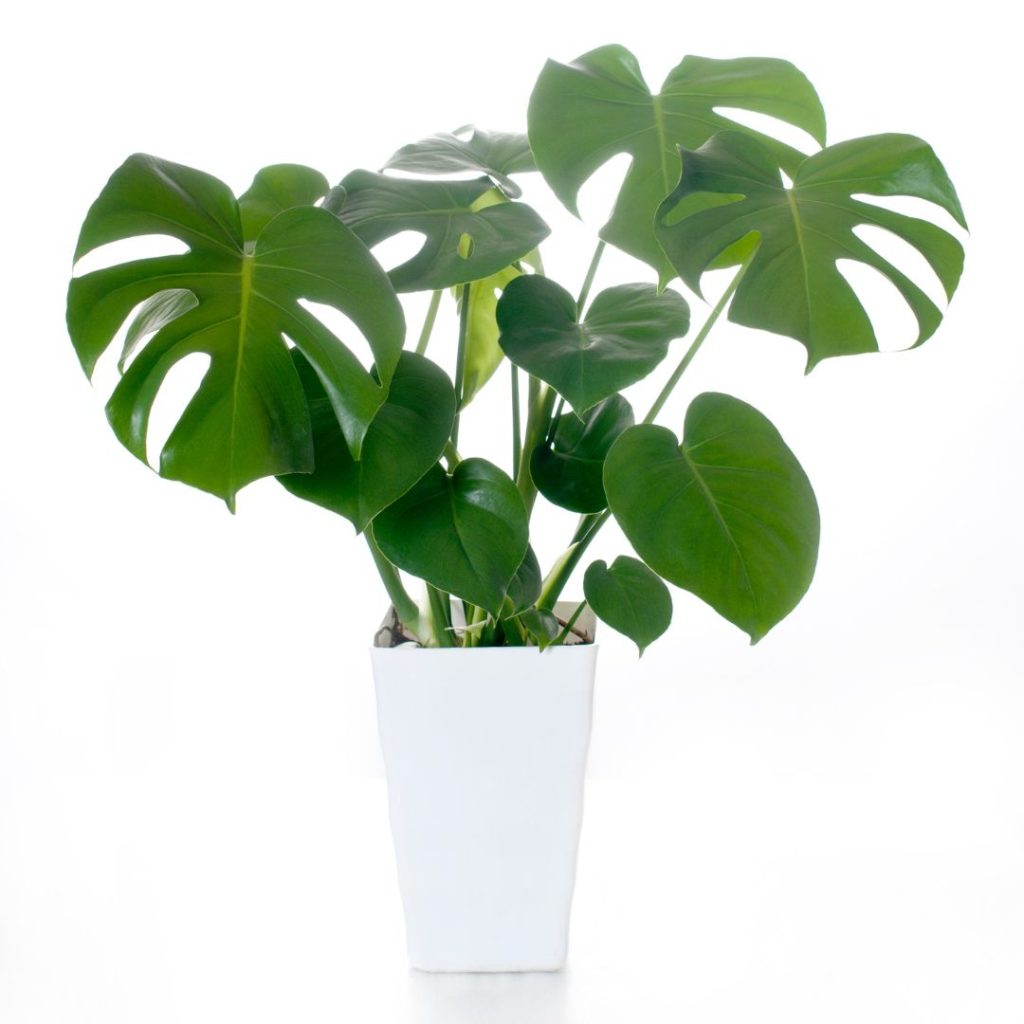
Another type of money plant is the Split-Leaf Money Plant, also known as the Swiss Cheese Plant. It’s easy to take care of and drought-tolerant. It can even survive in low-light conditions. Its large, split green leaves are said to bring luck and fortune to households that care for it properly. It should be kept in a large vase or planted in the garden.
This plant requires more water than other money plants, so it’s important to make sure it’s watered regularly. It’s also important to prune the leaves regularly to encourage new growth. If you’re looking for a money plant that’s easy to take care of, the Split-Leaf Money Plant is a great choice.
Related Post:
43 Different Types Of Monstera (With Pictures)
Silvery Ann Pothos
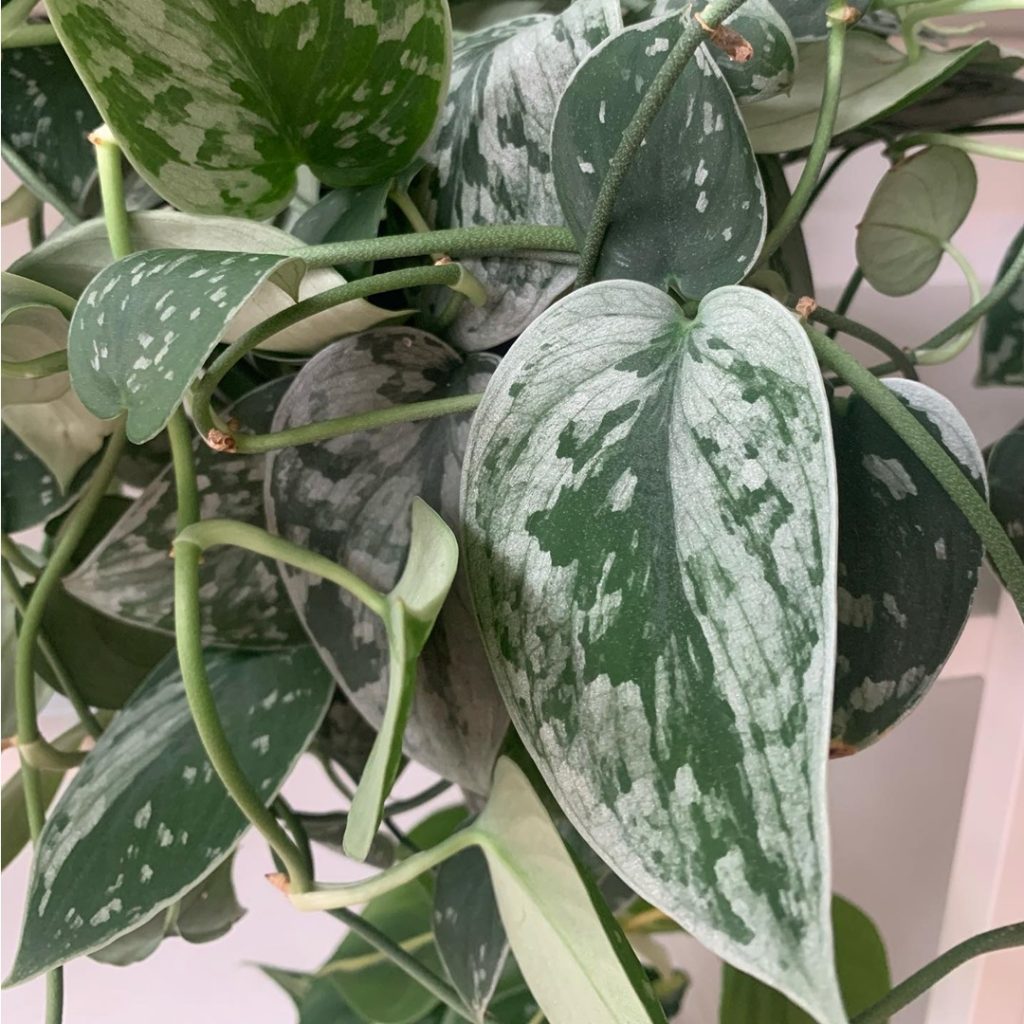
Meanwhile, Silvery Ann Pothos is another money plant that’s easy to take care of and boasts an enchanting silvery-green effect. Its unique variegation intensifies when exposed to bright light and it can adapt to various lighting conditions. Place your Silvery Ann Pothos in an area with bright, indirect light and maintain even moisture in the soil. Water when the top layer feels dry and ensure proper drainage to prevent waterlogged roots. This beautiful plant will add a captivating touch to your indoor garden and will thrive in a bright, well-lit environment.
Lucky Bamboo
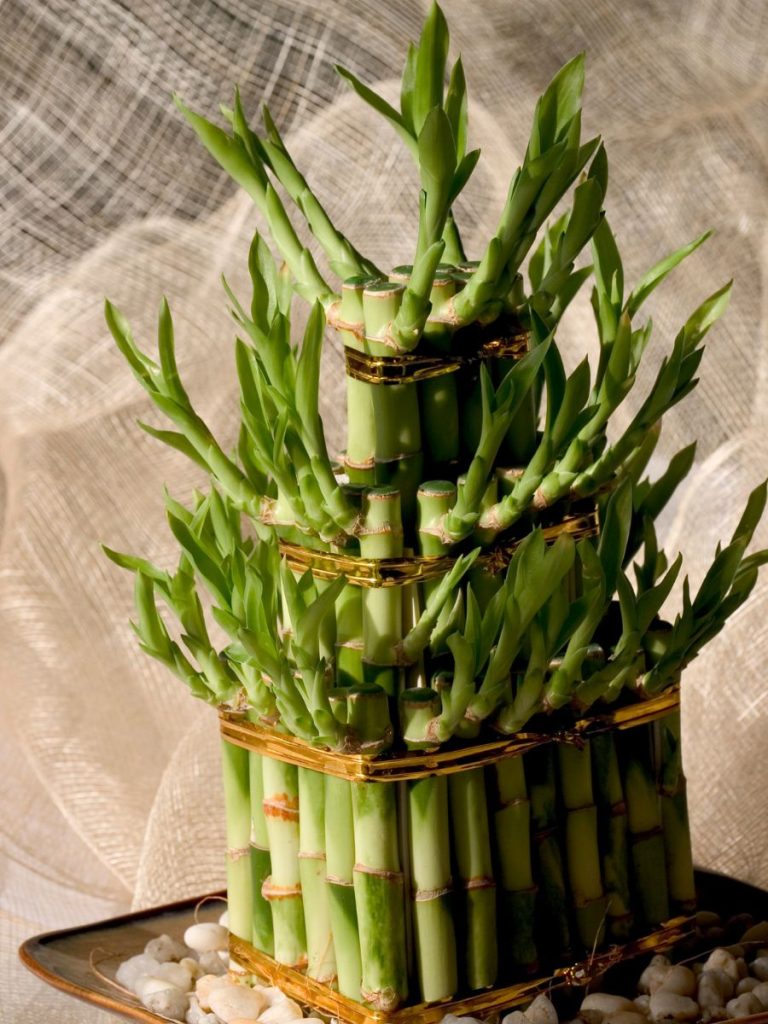
Continuing from the Silvery Ann Pothos, another popular variety of money plant is Lucky Bamboo. This plant is a unique, hardy species that can survive in a variety of indoor and outdoor environments. Lucky Bamboo is an excellent choice for those looking to add some interesting foliage to their home’s interior. It’s also an ideal choice for those who want to bring some luck and prosperity into their lives.
The Lucky Bamboo is a type of Dracaena, which is a genus of plants native to tropical Africa and Asia. It is a low-maintenance plant that requires minimal care and attention. The Lucky Bamboo can survive in low-light conditions and does not need to be watered regularly. It can be grown in a variety of containers, soil, and even rocks or water. This makes it a great choice for those who are looking for an easy-to-care-for money plant.
Marble Queen Pothos
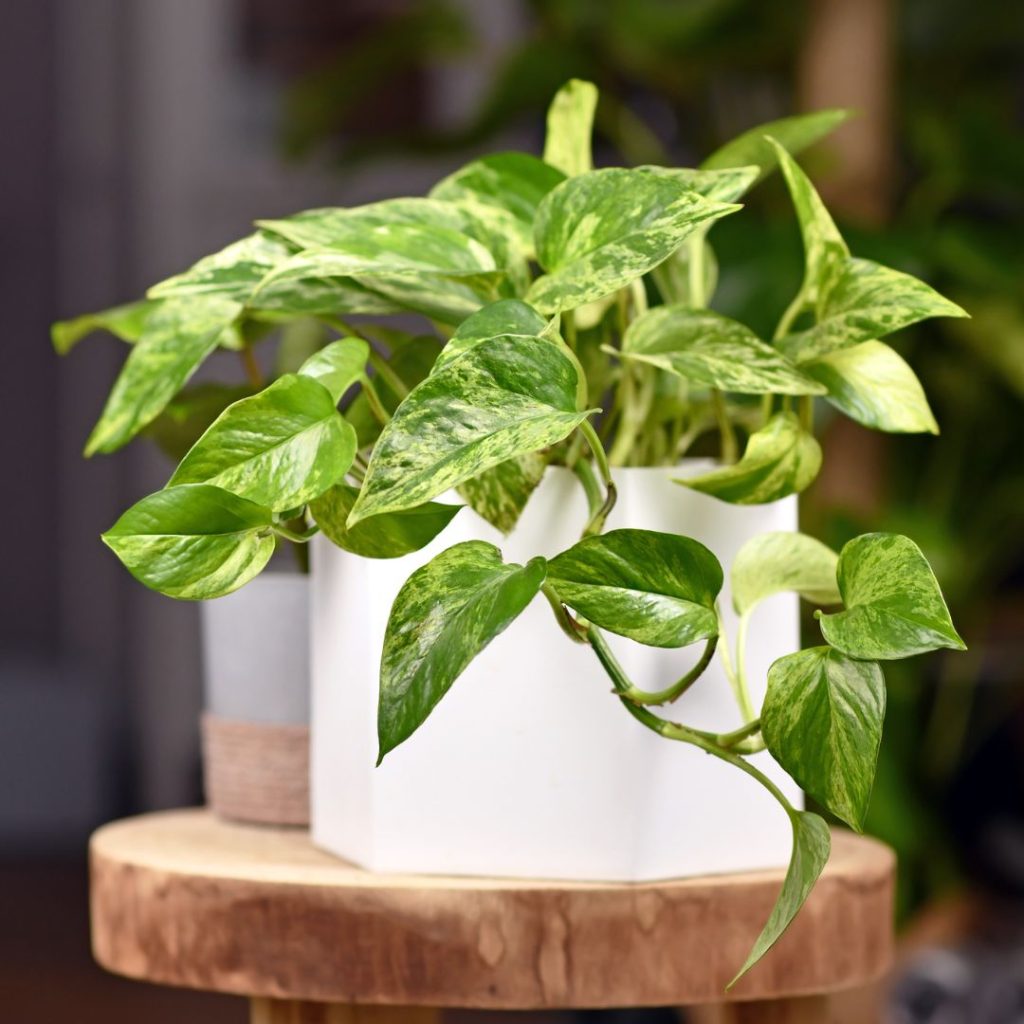
Grow the spectacular Marble Queen Pothos and enjoy its heart-shaped leaves in a beautiful contrast of creamy white and green. The botanical name for this money plant is Epipremnum aureum ‘Marble Queen’, and its care is quite easy. Place this plant in an area with bright indirect light, and make sure to only water it once the top quarter of the soil is dry. You can also provide it with something like a trellis to climb on, which will help it grow as a cascading plant. This money plant is a stunning addition to any home and is sure to bring you joy with its unique look.
Silver Money Plant
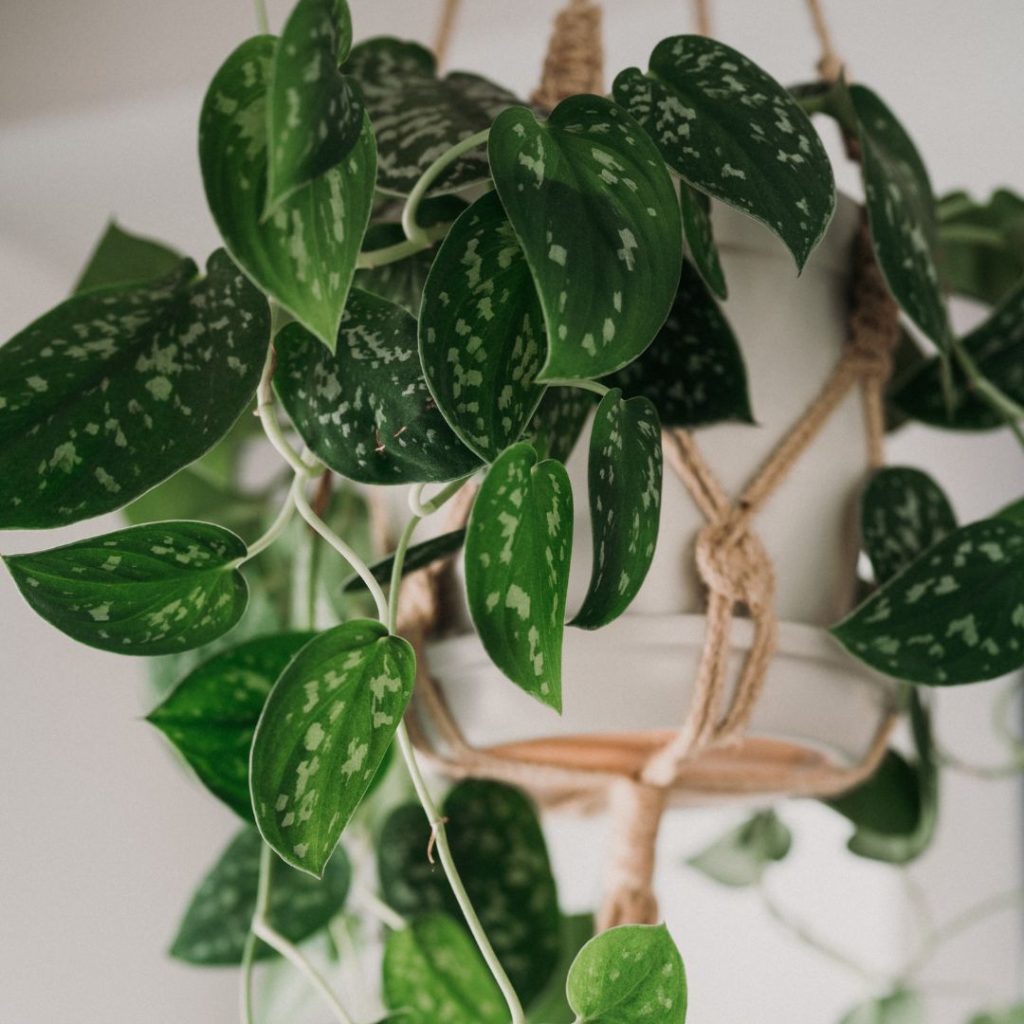
The second type of money plant is the Silver Money Plant, which has silver linings on its deep green leaves. Its botanical name is Scindapsus pictus. This climbing vine is a great, low-maintenance house plant and thrives in bright, indirect light. You can water it once every two weeks, allowing the soil to dry out between waterings. If it’s kept in low light conditions, water less often. With proper care, the Silver Money Plant will brighten up any home with its unique, velvety leaves and silver accents.
Neon Pothos
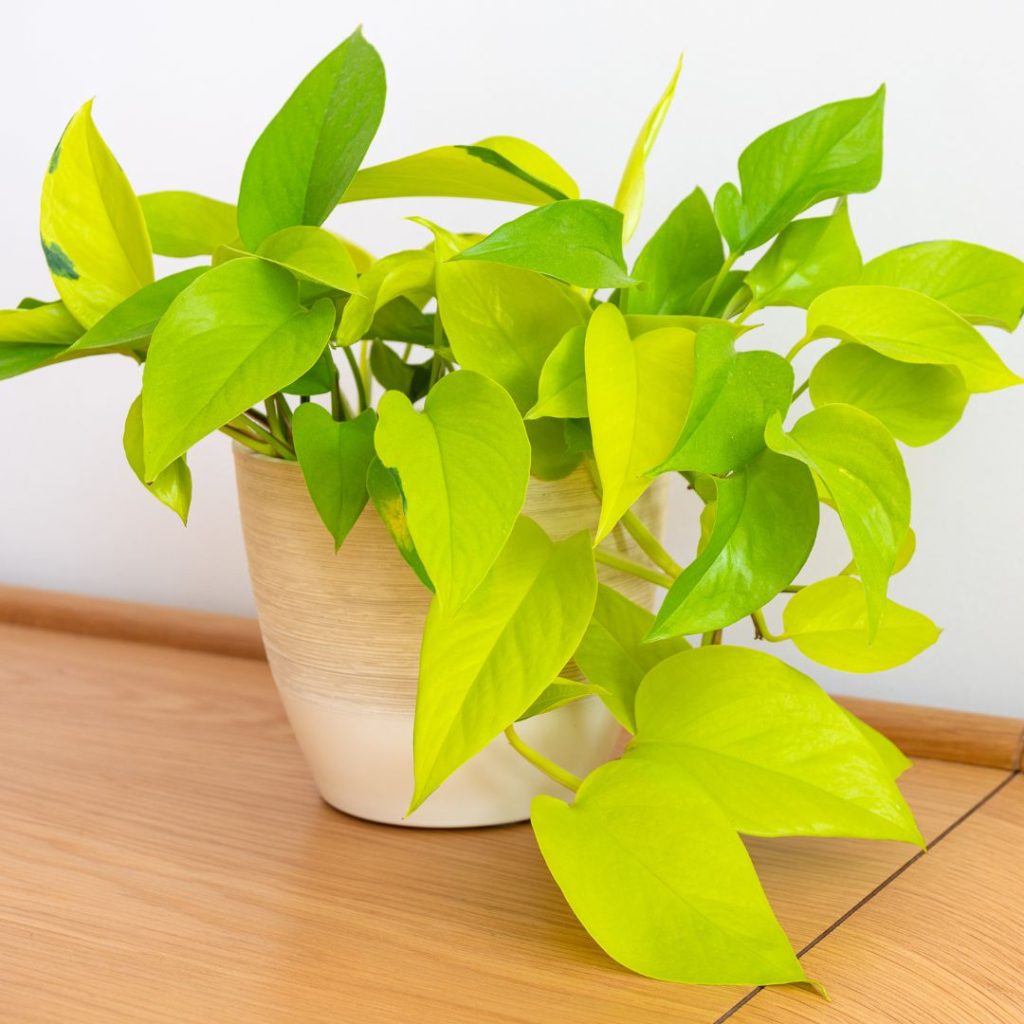
Following on from the Silver Money Plant, the Neon Pothos is a vibrant and eye-catching houseplant that you can easily keep indoors. Its distinct lime-green leaves make it a popular choice to add a splash of color to any room. This type of money plant grows best in bright indirect light, but can also adapt to other light conditions. When caring for the Neon Pothos, make sure to allow the soil to dry out between waterings to avoid root rot. With proper care, this money plant can be a beautiful addition to your home.
Silver Dollar Vine
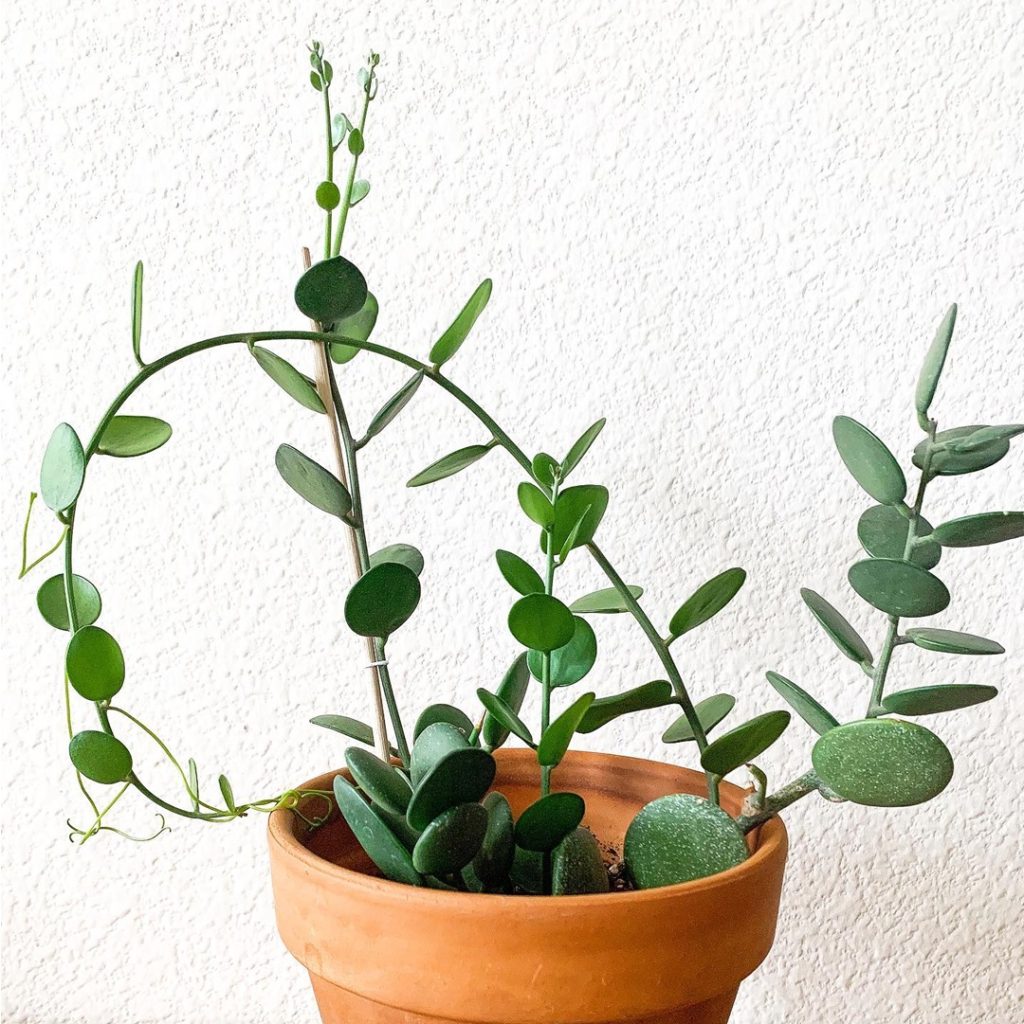
If you’re looking for a houseplant that brings an abundance of wealth, then the Silver Dollar Vine is the perfect choice! This climber has small succulent leaves and thrives in sunny windows, making it a great addition to any home. It is believed to bring prosperity and wealth to a household and is well suited to arid conditions.
Silver Dollar Vine is easy to care for and provides a healthy dose of luck and money. Its unique features make it a great option for any home or office, as it adds a touch of color to any environment. Keep in mind that it requires a bit of extra care, as it does not do well in overly wet conditions. With the right amount of attention, the Silver Dollar Vine can bring an abundance of wealth and good fortune into your life.
Rubber Plant
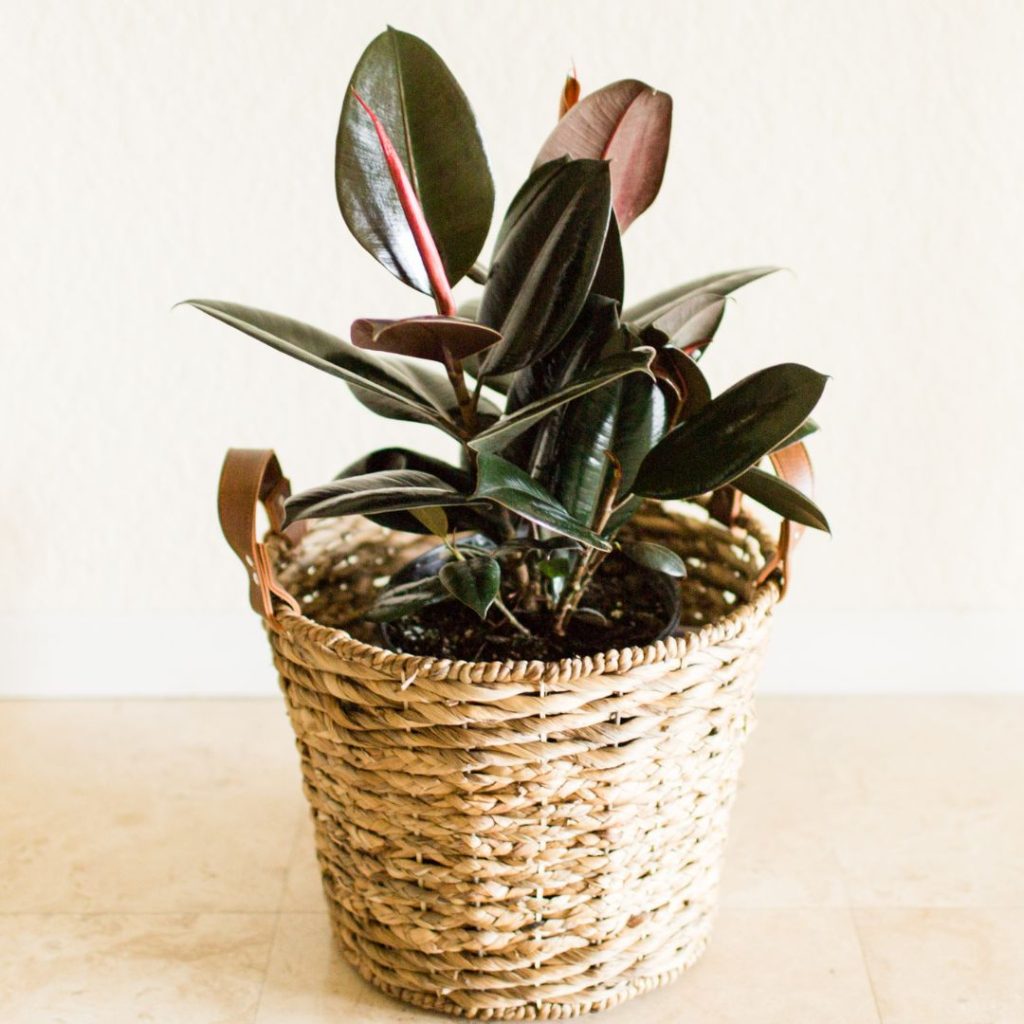
Another money-attracting plant is the Rubber Plant, which has large, glossy leaves and requires minimal care. It can thrive indoors or outdoors, as long as it’s in a warm, humid environment. This evergreen shrub can reach up to 10 feet tall. The leaves of the Rubber Plant are thick and leathery, and range in color from dark green to light green.
The plant also produces flowers in shades of white and yellow. Its hardiness and attractive foliage make it an ideal addition to any garden. Rubber Plants are low-maintenance plants, needing only occasional pruning and fertilizing. They also have pest-resistant qualities, making them a great choice for gardeners trying to attract money.
Monkey Mask Money Plant
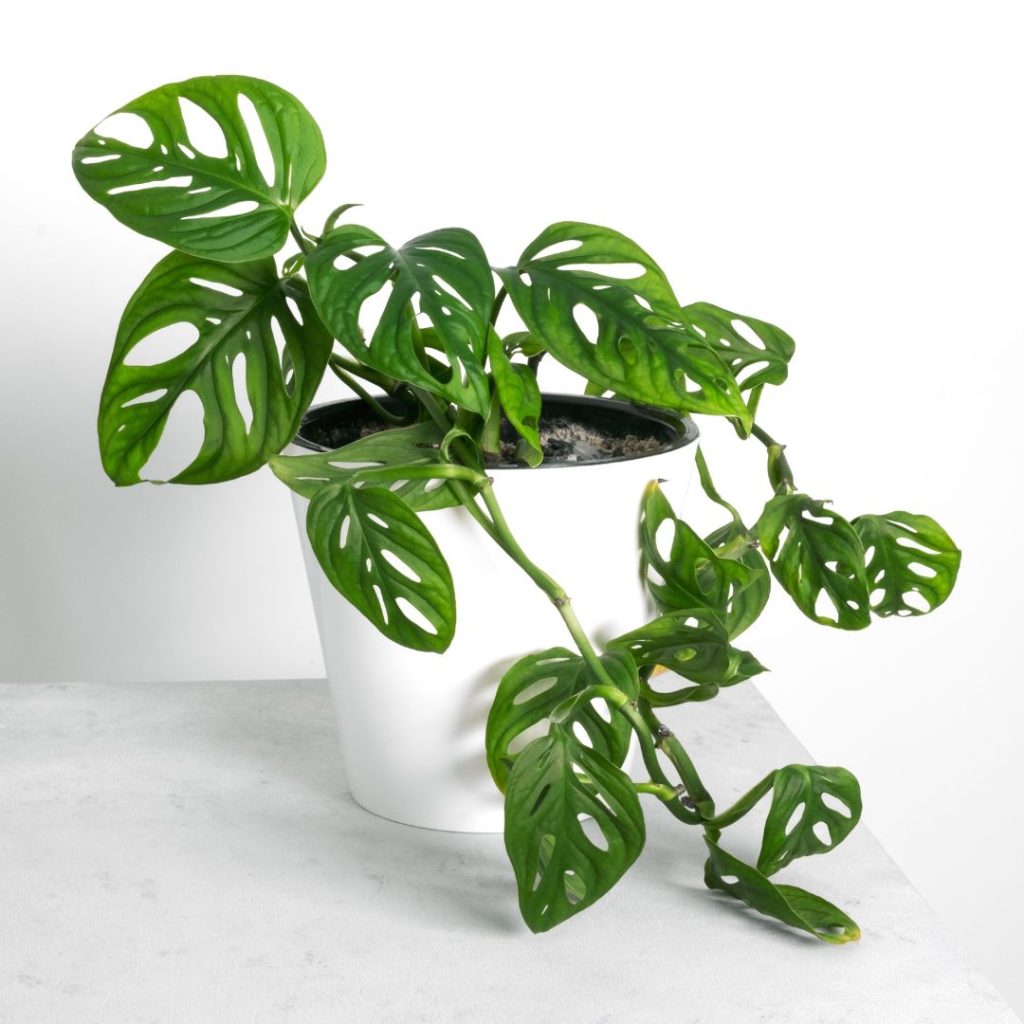
You can attract money with the Monkey Mask Money Plant, a large-leafed, perforated plant. Botanically known as Monstera adansonii, this unique money plant is often grown in the southeast corner of the living room as a cascading plant in hanging baskets. It’s also popular to let it climb a trellis for luck and fortune. The large, oval-shaped leaves have perforations, giving it a variegated appearance.
It’s a relatively easy-to-care-for plant that’s perfect for beginners. Keep it in a warm and humid environment with bright, indirect light, and water it when the top soil feels dry. Although it’s not as common as other money plants, its striking leaves make it an attractive addition to any home.
Big Leaf Money Plant
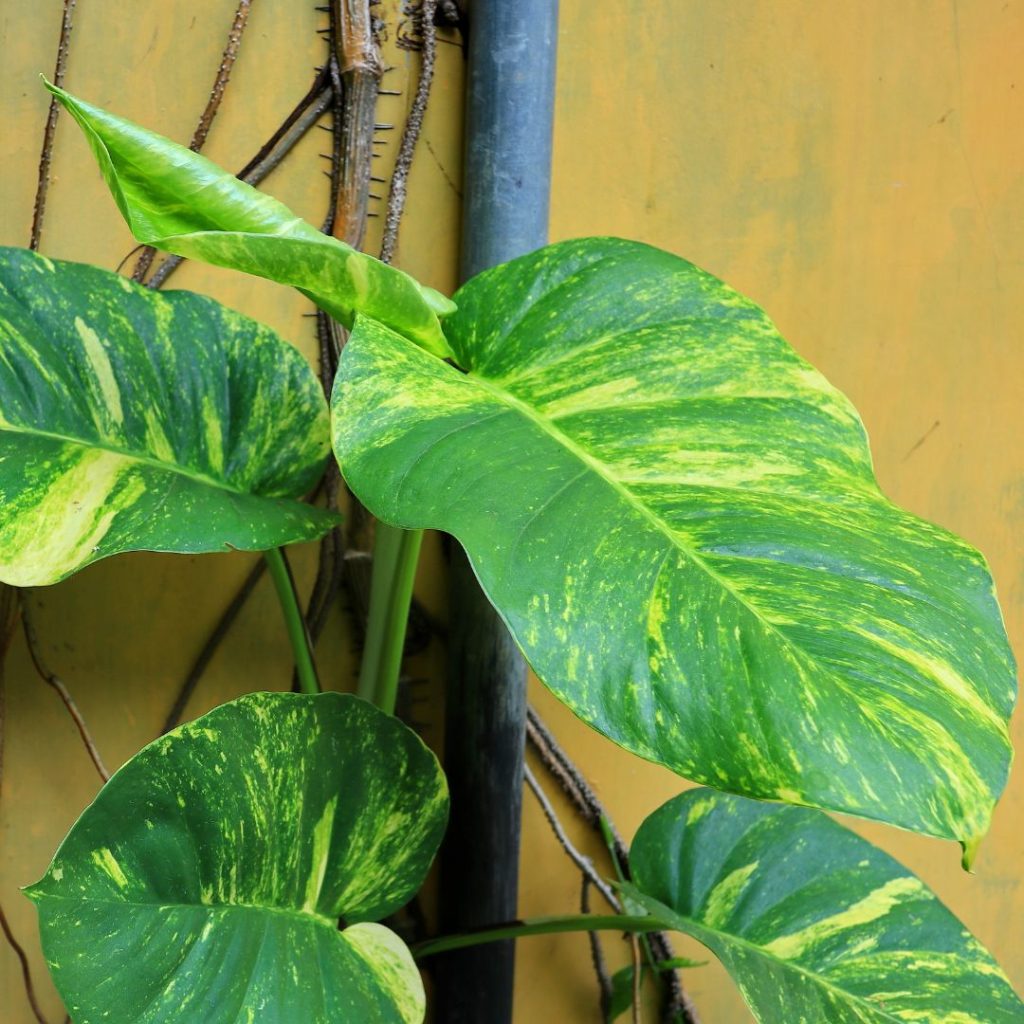
Next up is the Big Leaf Money Plant, a large-leafed climbing plant that grows up to 4 meters or more and is believed to bring luck and fortune. It is botanically known as Scindapsus aureus and is easy to care for. Its glossy leaves make it an attractive addition to any home or office space.
The Big Leaf Money Plant requires indirect light and should be watered regularly. To keep it looking its best, it should be pruned regularly, particularly if it is growing in an indoor space. Fertilizing the plant once a month is also recommended, as this will help to keep it healthy and strong. This type of Money Plant is a great choice for those looking for an aesthetically pleasing and low-maintenance plant that will bring luck and good fortune.
Marble Prince Pothos

Building on from the Big Leaf Money Plant, the Marble Prince Pothos is an attractive and easy-to-care-for plant that brings good luck and fortune. It has glossy green leaves with varying degrees of white or yellow coloration and is an ideal houseplant for any room. It is scientifically known as Epipremnum aureum ‘Marble Prince’, and should be kept in the southeast corner of any space for prosperity and wealth. Marble Prince Pothos is known to purify the air and is a popular choice among many cultures as a symbol of good luck. It does best in bright, indirect light and prefers moist, well-drained potting soil. Water your Marble Prince Pothos regularly and watch it thrive!
Pennywort
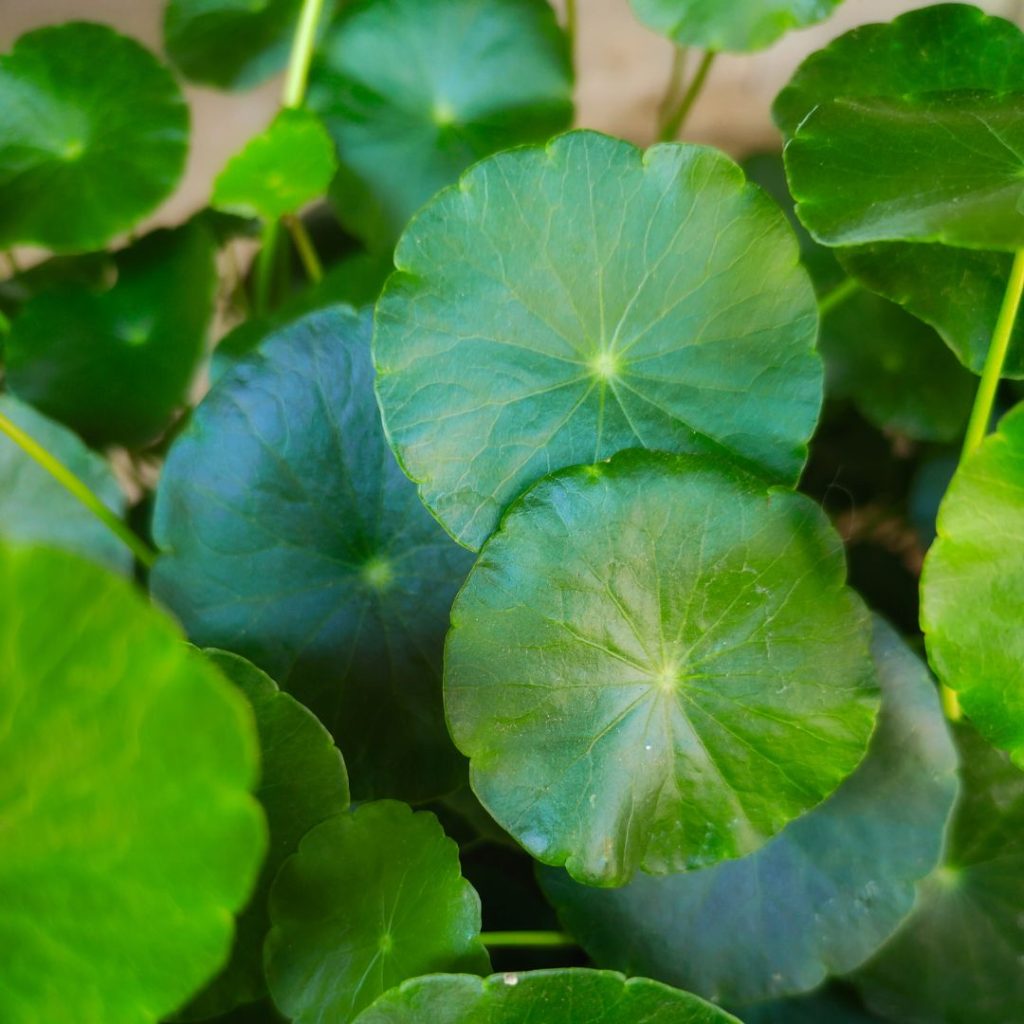
Following the Marble Prince Pothos, another money plant to consider for your home is Pennywort. This is an aquatic plant with small round leaves resembling coins, earning it the nickname “money plant”. It prefers to be kept in a fish tank or bowl of water and is a particularly rare houseplant. Pennywort is also known as Hydrocotyle vulgaris and is believed to attract financial fortune. When taking care of Pennywort, make sure that it has plenty of sunlight and water. It should also be trimmed regularly to keep it from becoming overgrown or unhealthy. With the right care, this unique plant can bring you luck and prosperity.
Ribbon Plant

Continuing on from Pennywort, the Ribbon Plant is another great choice for those looking for a money plant. Peperomia obtusifolia is a low-maintenance plant with thick, waxy leaves. It thrives in low to medium light and is a great addition to any indoor space. Place it in a well-lit area near a window or on a shelf to attract wealth.
The leaves of the Ribbon Plant are green and variegated, and they look like ribbons, giving the plant its name. It grows best in bright, indirect light and prefers to be kept moist but not soggy. With its easy-care requirements and attractive foliage, it’s no wonder the Ribbon Plant is a popular choice for money plants.
Bamboo Palm
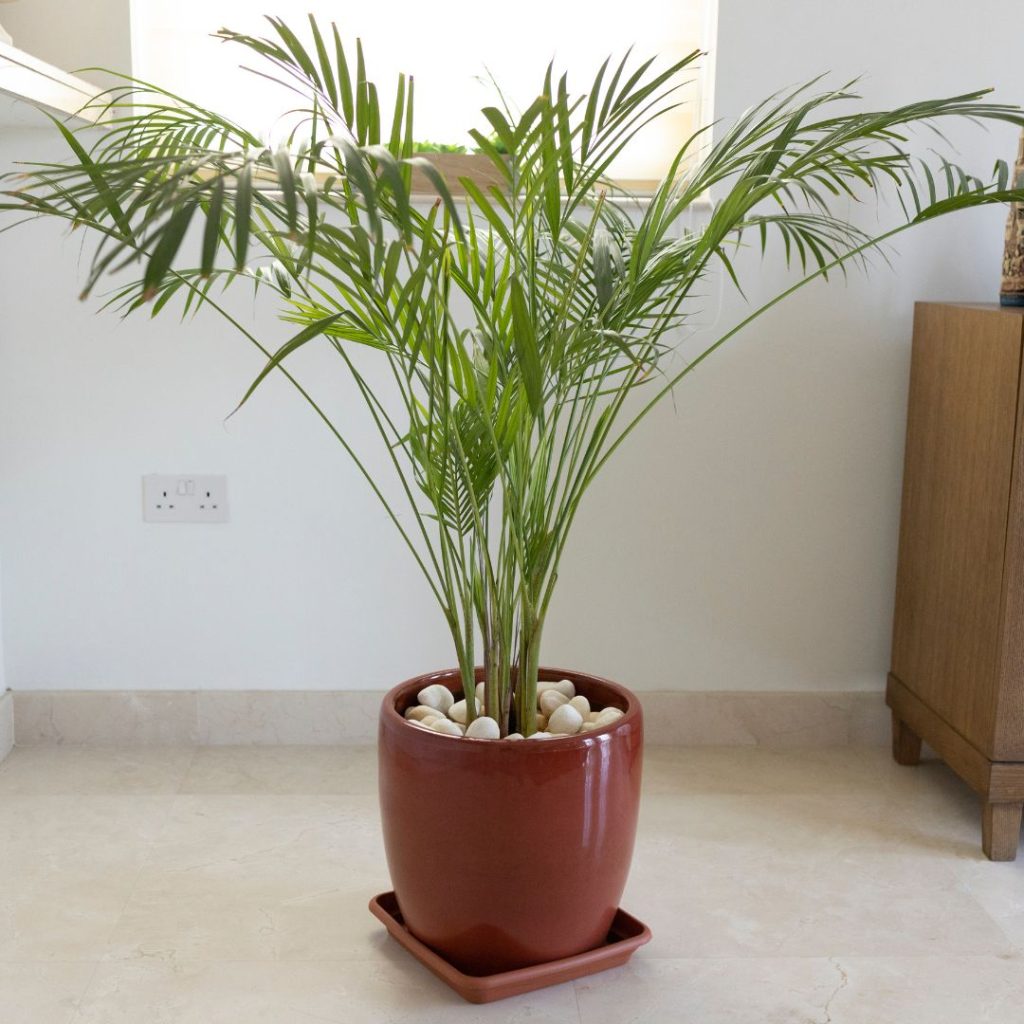
Another popular choice for a money plant is the Bamboo Palm, also known as Chamaedorea seifrizii. It’s a tall, graceful plant with slender green fronds that resemble bamboo stalks. To help it grow tall and strong, place it in a well-lit room. According to feng shui, it should be placed in the east or southeast corner of a room to attract wealth. Make sure to water the plant regularly and keep the soil moist. Prune the fronds and remove any dead leaves to keep it healthy. You can also use fertilizer during the spring to promote better growth. The Bamboo Palm is an attractive plant that can bring both beauty and good luck to a home.
Peace Lily
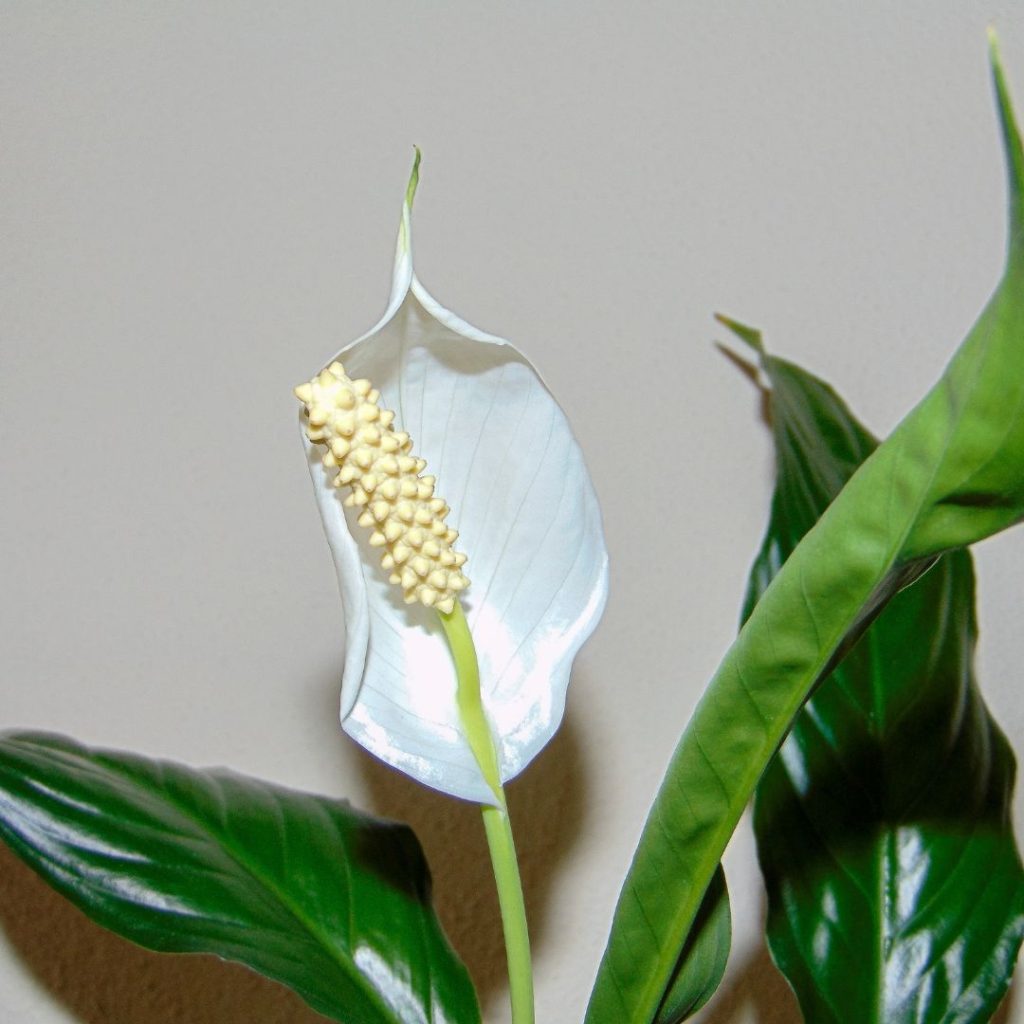
For a more elegant money plant, consider the Peace Lily, also known as Spathiphyllum wallisii. This tropical evergreen is a common houseplant and can reach up to two feet in height. Its waxy, dark green leaves can be spotted with white or cream-colored markings. The Peace Lily blooms in spring, producing white, boat-shaped flowers. The flowers are said to resemble a white flag, hence the name.
This plant is relatively easy to care for, requiring bright indirect light and consistently moist soil. It can also thrive in low-light conditions and is tolerant of occasional overwatering. Fertilize the Peace Lily with a balanced fertilizer to promote healthy growth and blooms. Keep the Peace Lily in temperatures between 60-80°F and avoid direct sunlight, as this can cause scorching of the leaves. With proper care, the Peace Lily can be a beautiful addition to any home.
Jade Pothos
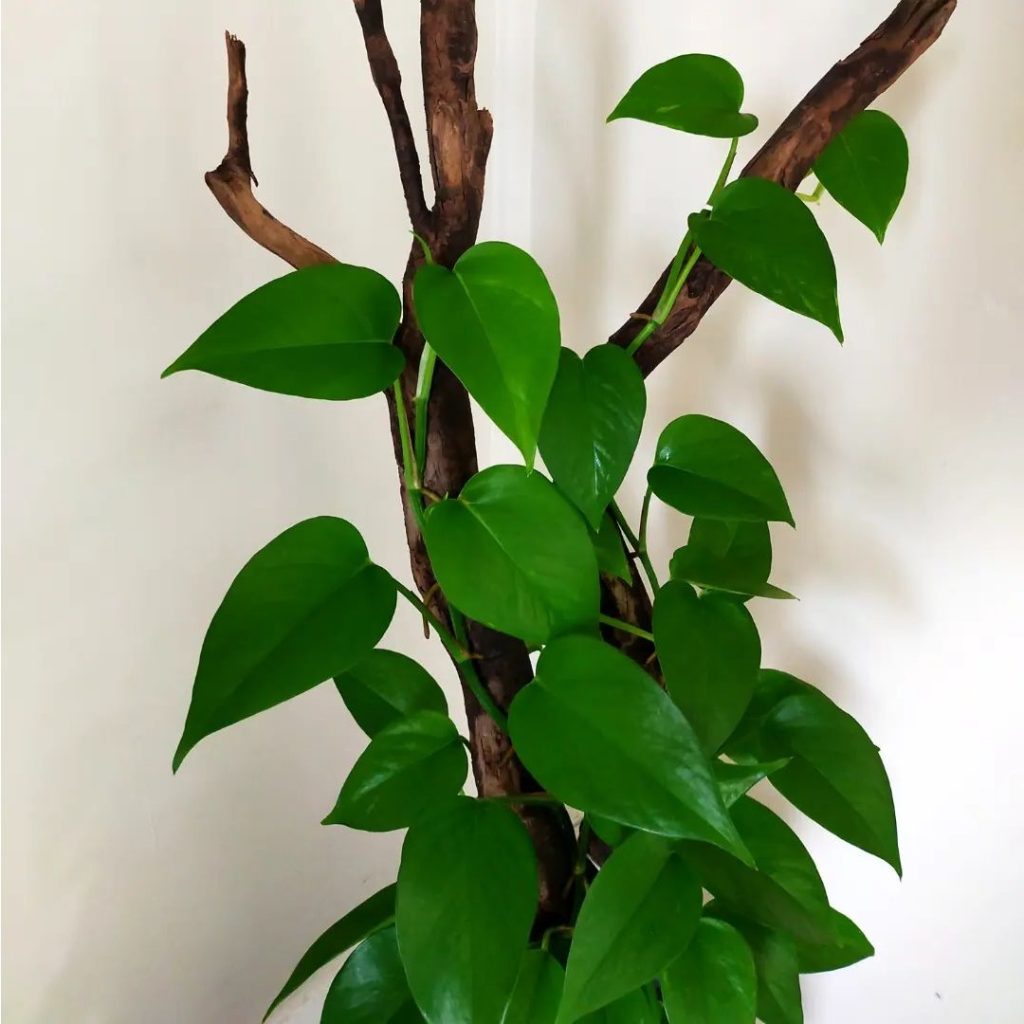
Following on from the Peace Lily, Jade Pothos is another great money plant option, featuring glossy, dark green leaves and a compact, bushy shape. Its lush foliage and resilience make it ideal for rooms with limited sunlight. To keep it healthy, place it in indirect light and water it sparingly. Allow the top inch of soil to dry out before each watering. With its hardiness and adaptability, Jade Pothos is a great choice for anyone looking to add a touch of elegance to their home. Plus, its ability to thrive in low light conditions means it’ll do well even in the most challenging environments.
Manjula Pothos
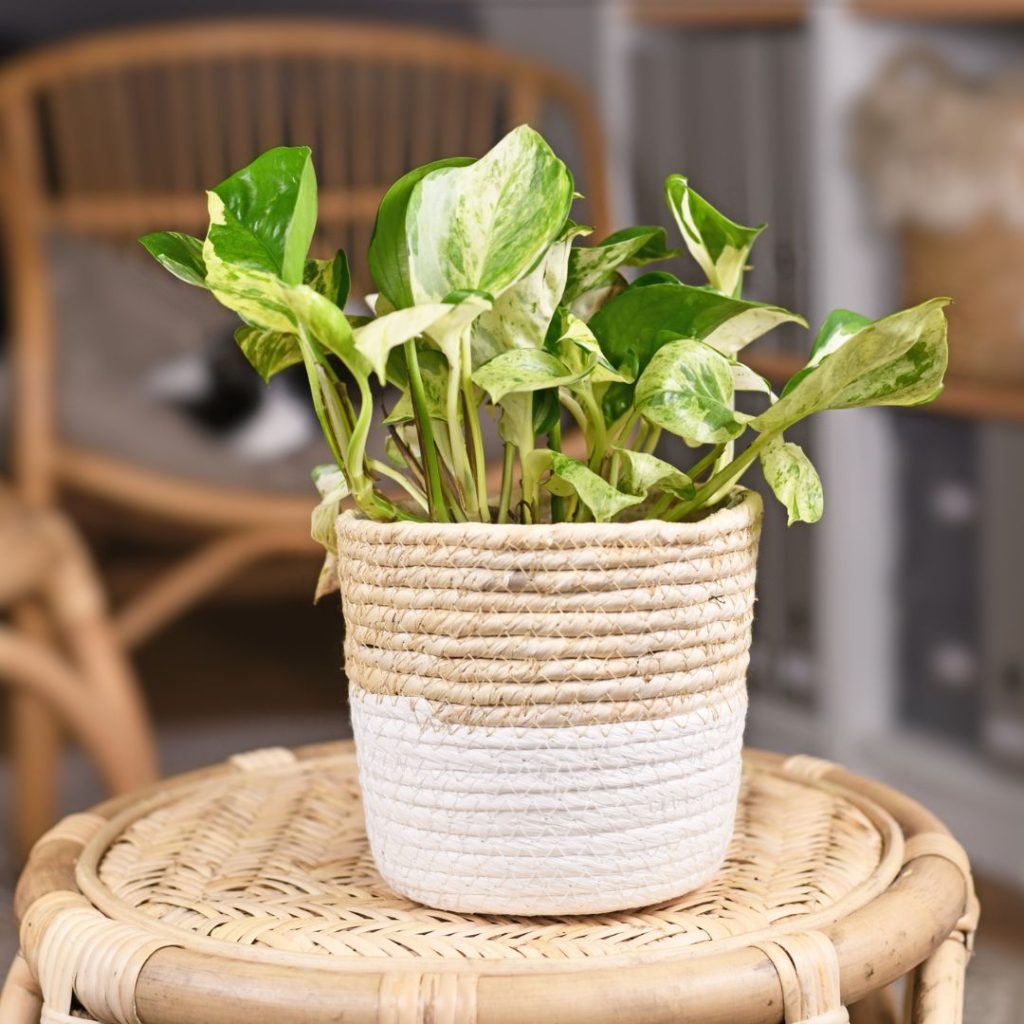
If you’re looking for a unique money plant to add to your collection, Manjula Pothos is an excellent choice. It features broad leaves with creamy white and silvery-green variegation, creating an elegant look that is sure to impress. This newer cultivar is known for its low maintenance requirements, so you don’t have to worry about a lot of upkeep. Place it in bright, indirect sunlight to maintain its variegation, and keep the soil moist without waterlogging. Proper drainage is also important to prevent root rot. With its attractive appearance and easy care, Manjula Pothos is the perfect addition to any home.
N’Joy Pothos
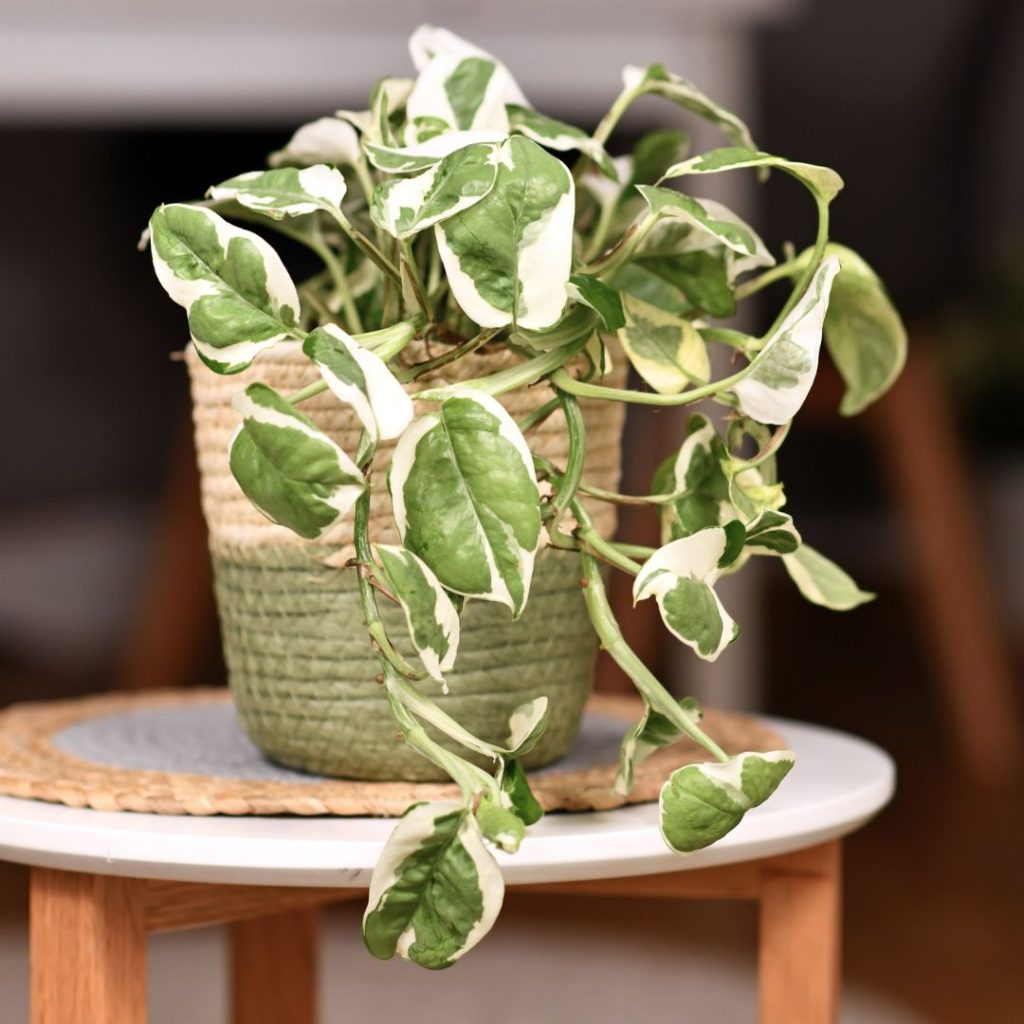
Continuing on from Manjula Pothos, another one of the different types of money plants is N’Joy Pothos, which features slender, heart-shaped leaves with creamy-white streaks. This elegant plant is sure to brighten up any room. It is also adaptable to different humidity levels, making it perfect for homes with fluctuating environments.
To keep it healthy, give your N’Joy Pothos moderate, indirect light and maintain even moisture in the soil. Water the plant when the top inch feels dry and try to avoid overwatering as this can harm its roots. With proper care, this beautiful money plant will bring joy to your home for years to come.
Cebu Blue Pothos

Building on the N’Joy Pothos, the Cebu Blue Pothos is a popular type of money plant with its striking blue-green leaves and climbing habit. Its leaves are elongated and slightly serrated, adding to its unique visual appeal.
Unlike most money plants, it’s often grown as a trailing or climbing vine; it can be placed in a hanging basket, on a trellis, or trained to climb supports. It prefers bright, indirect sunlight and should be watered when the top inch of soil dries out. With the right support, its ornamental value will greatly enhance any space. This money plant is sure to provide a unique, eye-catching display.
Hawaiian Pothos
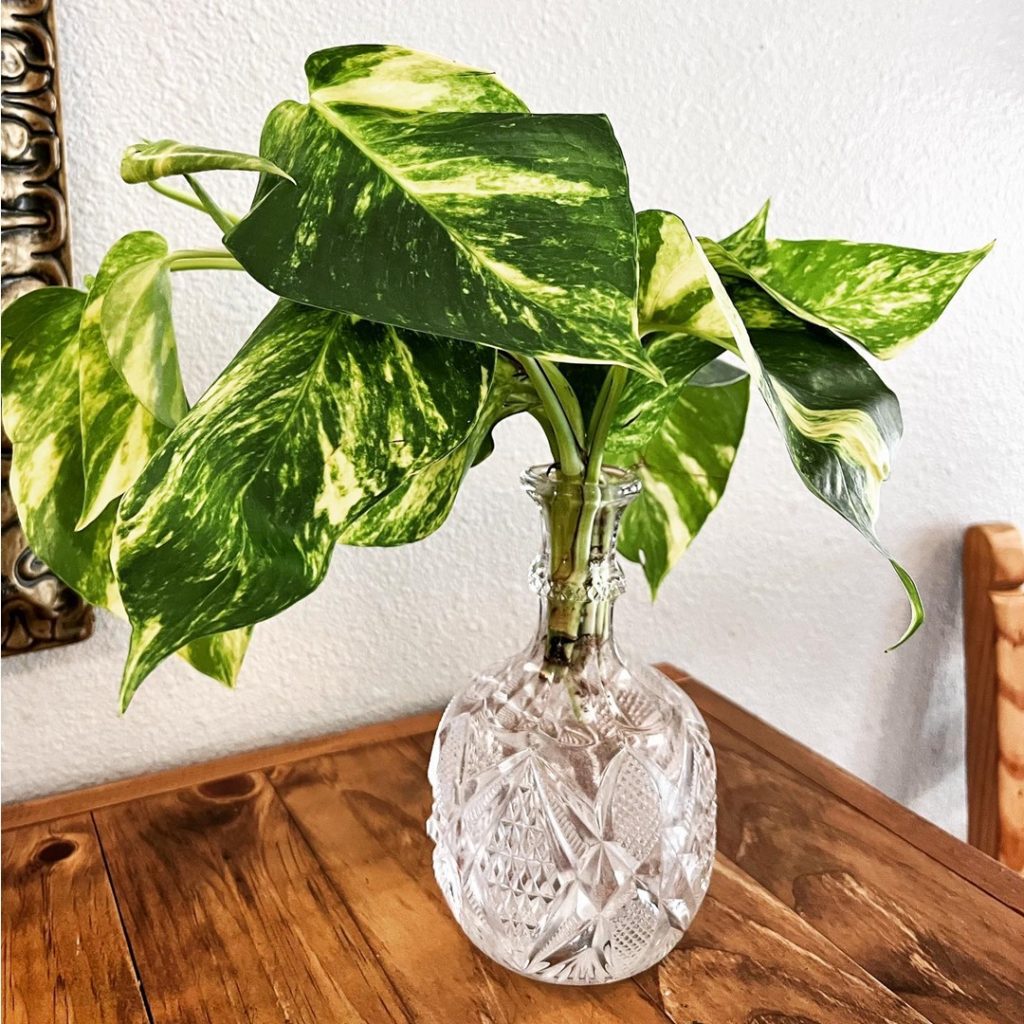
Like the Cebu Blue Pothos, Hawaiian Pothos showcases vibrant, contrasting colors that make it a visually appealing addition to any indoor garden. Its scientific name is Epipremnum aureum ‘Hawaiian’, and its lime-green leaves are highlighted with golden-yellow variegation. Despite its name, this plant is native to the Solomon Islands. To keep its colors vibrant, provide Hawaiian Pothos with bright, indirect light and water when the top layer of soil dries out. Drainage is key to preventing root issues. With its tropical allure, this plant is sure to bring life to your indoor garden.
Glacier Pothos

The second type of money plant is Glacier Pothos, which has a unique blend of green, white, and silver variegation for a stunning icy effect. It is renowned for its captivating appearance and thrives in conditions with bright, indirect sunlight. Give it even moisture and proper drainage, and allow the top layer of soil to dry out between waterings.
This gorgeous plant can add a touch of elegance to your indoor space and create a beautiful focal point. It is safe and easy to care for, making it the perfect addition to your home or office. With its eye-catching foliage and low-maintenance requirements, Glacier Pothos is an ideal choice for any indoor garden.
Conclusion
Money plants are a beautiful addition to any home or office. Not only do they bring aesthetic beauty, but they can also bring luck and prosperity. Studies show that an impressive 82% of people who have money plants in their homes have reported an increase in their financial stability. So why not give money plants a try and see if it brings you the luck and wealth you’ve been looking for?
